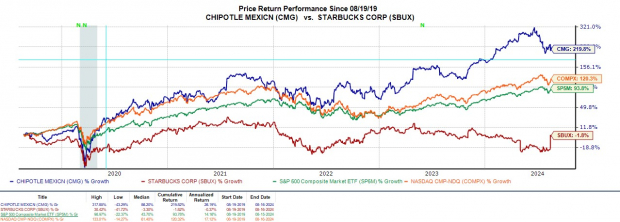The Changing of the Guard
In a surprising twist of fate, Chipotle Mexican Grill’s CEO Brian Niccol will be leaving to helm Starbucks. The imminent takeover raises questions for investors torn between these retail restaurant stocks.
A Journey Through Growth
Chipotle’s recent performance under Niccol has been stellar, with the stock soaring over +200% in the last five years, a stark comparison to Starbucks’ -2% growth. However, past successes do not necessarily guarantee future triumphs.
Forecasted Growth Figures
Chipotle’s projected earnings showcase a promising outlook, with a 20% increase expected in fiscal 2024 and a further 18% growth in FY25. Total sales are anticipated to rise by 15% this year and another 13% in FY25, reaching $12.79 billion.
Conversely, Starbucks is forecasted for a slower growth trajectory, with an 11% rise in earnings forecasted for FY25. Total sales are expected to increase by 1% in FY24 and then by 6% in the following year, reaching $38.84 billion.
Peering into Valuations
Chipotle may be leading in growth, but Starbucks seems to offer a more enticing valuation, trading near the S&P 500’s 23.3X forward earnings. In contrast, Chipotle trades at a premium of 49.7X, indicating a potential downside for investors.
Balancing the Sheets
While Starbucks boasts higher cash reserves, Chipotle’s balance sheet appears stronger, with $1.49 billion in cash & equivalents and total assets of $8.92 billion, overshadowing its liabilities of $5.2 billion.
In comparison, Starbucks holds $3.39 billion in cash & equivalents but is burdened with total liabilities of $38.04 billion against assets of $30.11 billion, raising concerns about financial stability.
Wrapping Up
Starbucks faces challenges in operational performance with looming insolvency concerns. However, with Niccol at the helm, hopes are high for Starbucks to reach the same heights as Chipotle. Currently both these stocks carry a Zacks Rank #3 (Hold), offering potential long-term investment opportunities amidst favorable outlooks but possibly better entry points in the future.

